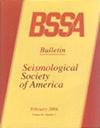A Methodology to Combine Shaking and Ground Failure Models for Forecasting Seismic Damage to Buried Pipeline Networks
IF 2.9
3区 地球科学
Q2 GEOCHEMISTRY & GEOPHYSICS
引用次数: 0
Abstract
How does an earthquake affect buried pipeline networks? It is well known that the seismic performance of buried pipelines depends on ground failures (GFs) as well as strong ground shaking (SGS), but it is unclear how the various types of earthquake hazards should be collectively combined, as existing methodologies tend to examine each of the earthquake hazards separately. In this article, we develop a probability-based methodology to consistently combine SGS with three types of GF (surface faulting, liquefaction, and landslide) for forecasting seismic damage in buried pipeline networks from a given earthquake rupture scenario. Using a gas transmission pipeline example, we illustrate how the proposed methodology enables others (e.g., researchers, pipeline operators who manage distribution lines, and consultants) to modularly combine various models such as those for estimating probability of GF, permanent ground displacements, and pipeline fragility. Finally, we compare the proposed methodology against the Hazus methodology to explore implications from considering each hazard one at a time.一种结合地震和地面破坏模型预测地下管网震害的方法
地震是如何影响地下管网的?众所周知,埋地管道的抗震性能取决于地震动(gs)和强地震动(SGS),但目前尚不清楚如何将各种类型的地震灾害综合起来,因为现有的方法倾向于单独检查每种地震灾害。在本文中,我们开发了一种基于概率的方法,将SGS与三种类型的GF(地表断裂、液化和滑坡)相结合,用于预测给定地震破裂情景下埋地管网的地震破坏。以天然气输送管道为例,我们说明了所提出的方法如何使其他人(例如,研究人员、管理配电线路的管道运营商和顾问)能够模块化地组合各种模型,例如用于估计GF概率、永久地面位移和管道易损性的模型。最后,我们将提出的方法与Hazus方法进行比较,以探索每次考虑每个危害的含义。
本文章由计算机程序翻译,如有差异,请以英文原文为准。
求助全文
约1分钟内获得全文
求助全文
来源期刊

Bulletin of the Seismological Society of America
地学-地球化学与地球物理
CiteScore
5.80
自引率
13.30%
发文量
140
审稿时长
3 months
期刊介绍:
The Bulletin of the Seismological Society of America, commonly referred to as BSSA, (ISSN 0037-1106) is the premier journal of advanced research in earthquake seismology and related disciplines. It first appeared in 1911 and became a bimonthly in 1963. Each issue is composed of scientific papers on the various aspects of seismology, including investigation of specific earthquakes, theoretical and observational studies of seismic waves, inverse methods for determining the structure of the Earth or the dynamics of the earthquake source, seismometry, earthquake hazard and risk estimation, seismotectonics, and earthquake engineering. Special issues focus on important earthquakes or rapidly changing topics in seismology. BSSA is published by the Seismological Society of America.
 求助内容:
求助内容: 应助结果提醒方式:
应助结果提醒方式:


